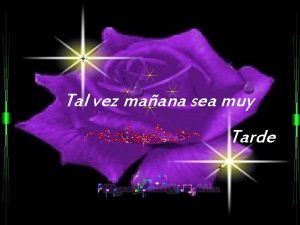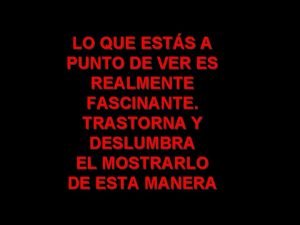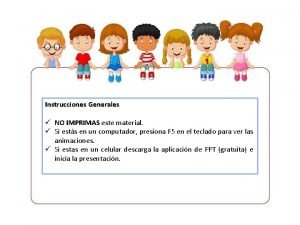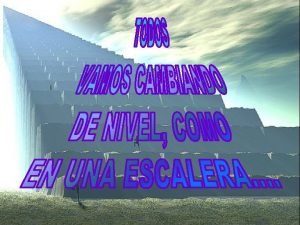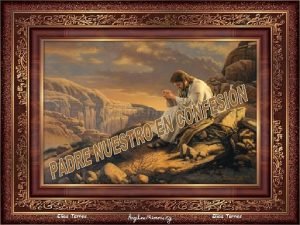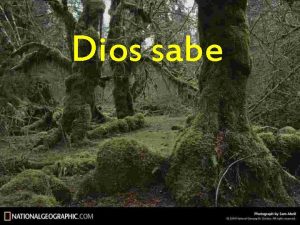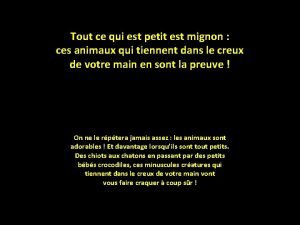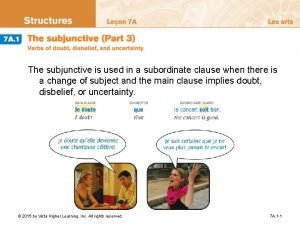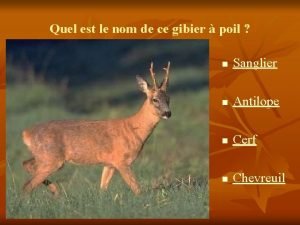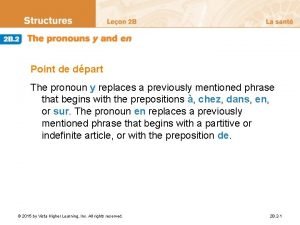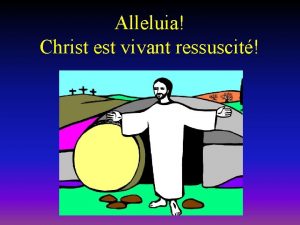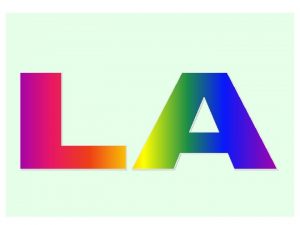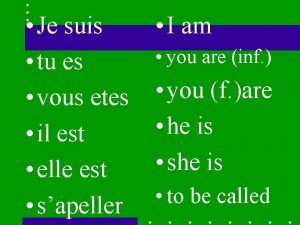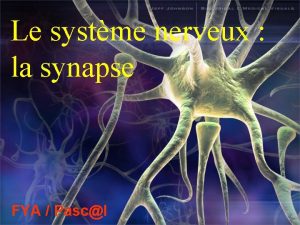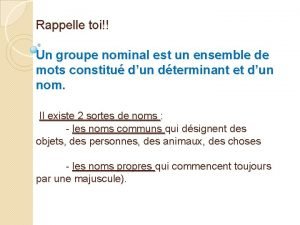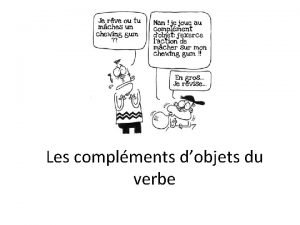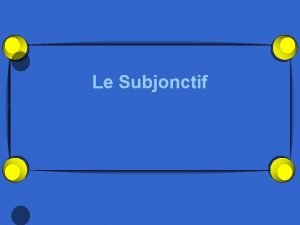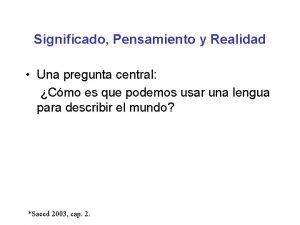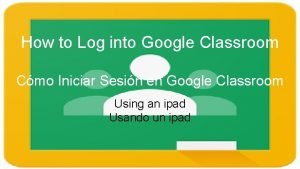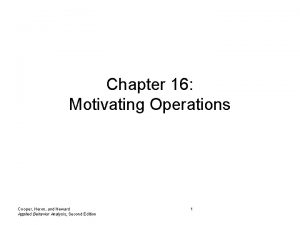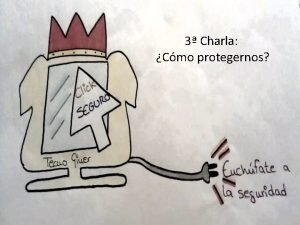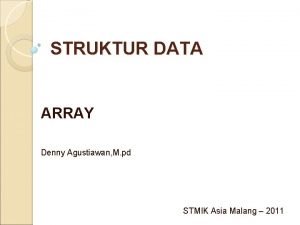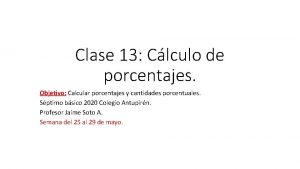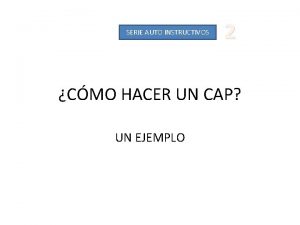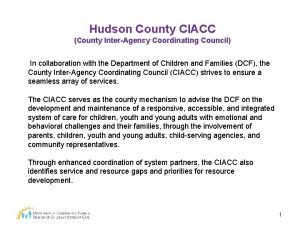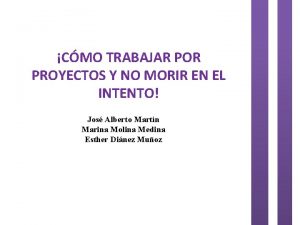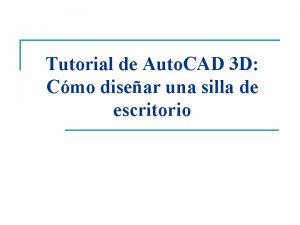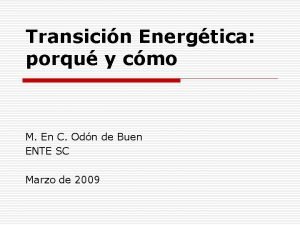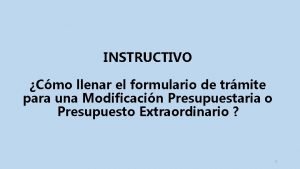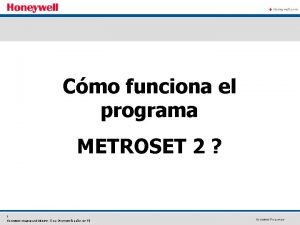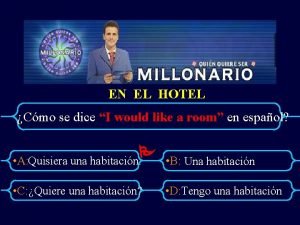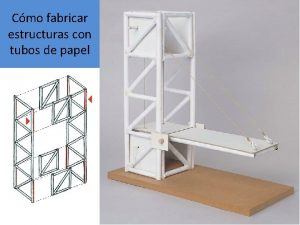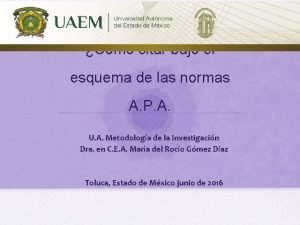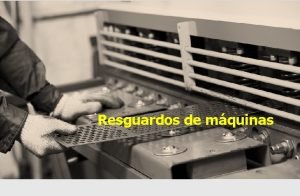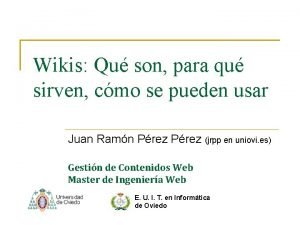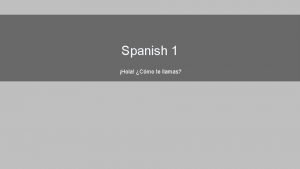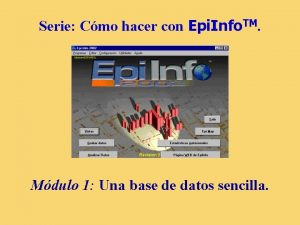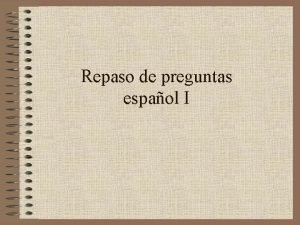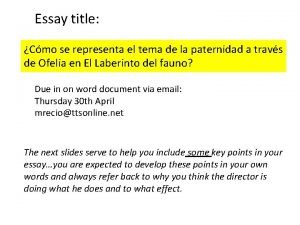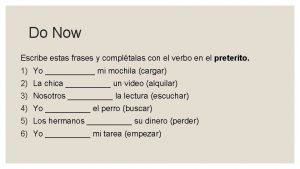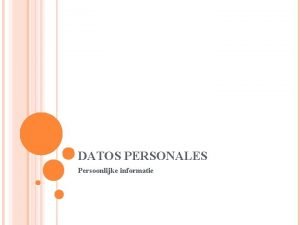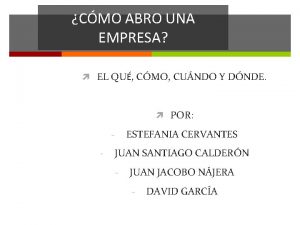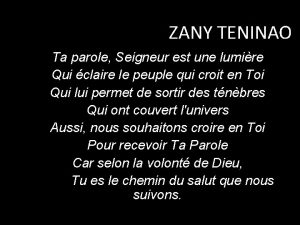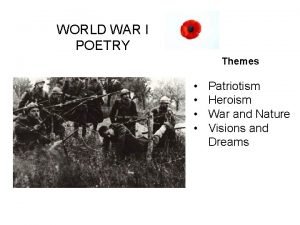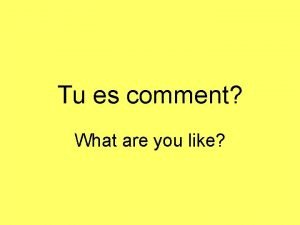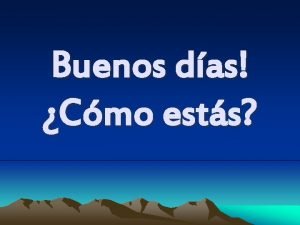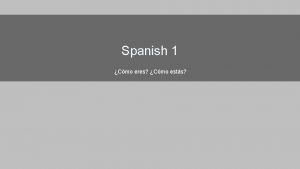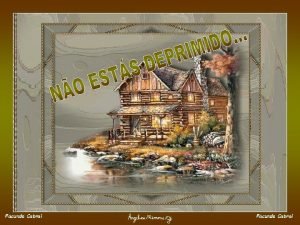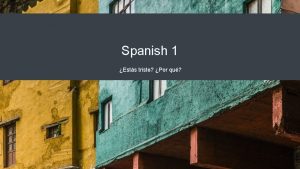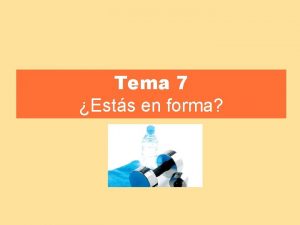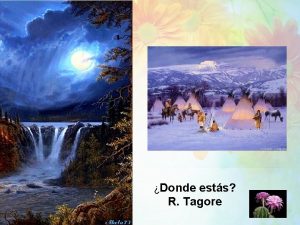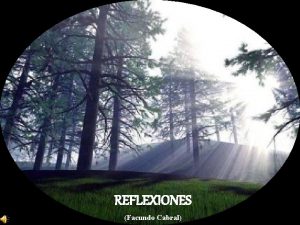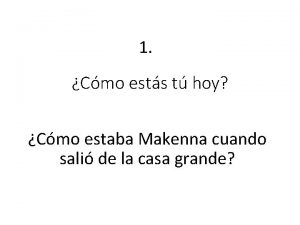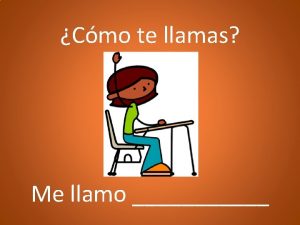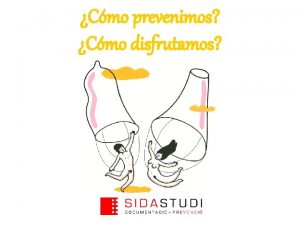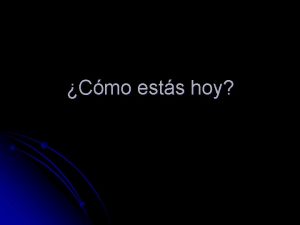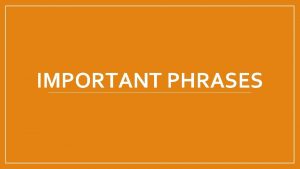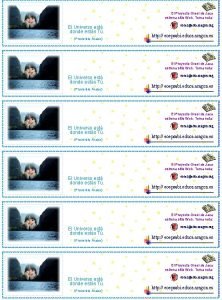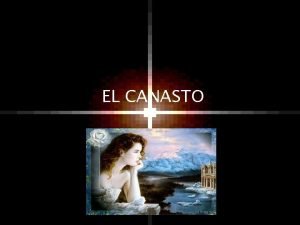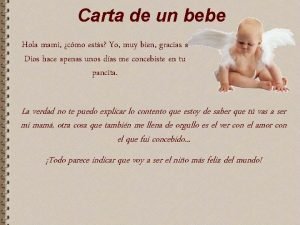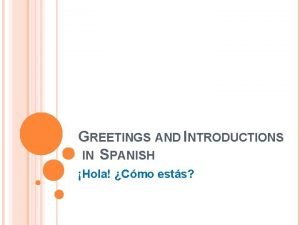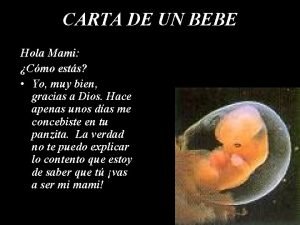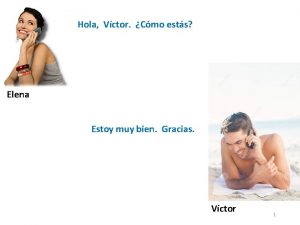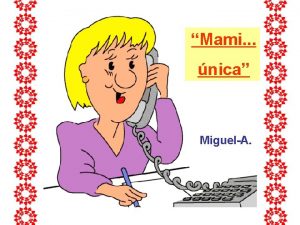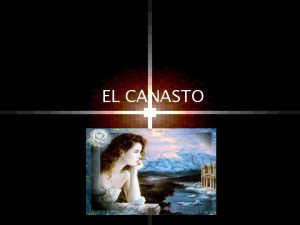Cmo ests Cmo est How are you The
























































































































- Slides: 120

¿Cómo estás? / ¿Cómo está? -- How are you? — The first form (which is informal) normally would be used with someone you know on a first-name basis or when speaking with a child. The second form generally would be used in other situations. Usage can depend quite a bit on where you are; in some areas, the informal form (estás) would be expected where under the same circumstances the formal form would be used in other areas. If you're a foreigner, chances are no one will criticize you for using the wrong form, although you may be politely corrected.

Saludos / greetings. ¿Cómo estás? How are you? informal ¿Cómo está ? How are you? formal estoy Bien Mal Muy mal Más o menos Muy bien Regular Terrible I am Fine Bad Very bad So so Very well Okay Terrible

Actividad • Walk around the room and give the appropriate greeting and ask how the other person is doing. • • • • Ejemplo: Buenos días, Señora Jurgensen, ¿cómo está usted? Bien gracias ¿y tú? Or ¿Y usted? Más o menos Regular Muy bien Mal Bien Buenos días Carlos, ¿cómo estás? Bien gracias ¿y tú? Or ¿Y usted? Más o menos Regular Muy bien Mal Bien

Lección Preliminar Objectives / Focus Learn about greetings Learn about introductions Learn how to say where people are from Learn the numbers 0 -12 and exchange telephone numbers • Learn to say the days of the week • Learn to describe the weather • Learn classroom phrases • •

El Alfabeto Español Which letters are different? ABCDEF G H I J K L LL M N Ñ O P Q R RR S TUVWXYZ

Nombre Sonido A A As in father B Be Between a B and V sounds C Ce D De Before consonants a, o, u like a “C” in car; before e and i like a “S” Like the English “D” E E As in “hey” F efe Like the “F” in Fox G Ge Before e and i, like the Spanish J; otherwise like a g in “get” H hache Silent i I Sounds like “meet”

Letra Nombre Sonido J Jota like an “h” but stronger k Ca Like a “K” L Ele Like an “L” Ll Elle Like the “Y” in you M Eme Like an “m” N Ene Like an “n” O O As in “woke” P Pe Like a “p” Q Cu Like a “K”; always followed by a silent “u”

Letra Nombre Sonido El abecedario R Ere Pronounced like a strong trill at the beginning of a word, and a medium trill in other positions Rr erre Strongly trilled S ese Like a “s” T Te Like a “t” U U Sounds like “boot” V Ve Between a “b” and “v” W Doble ve Usually like a “V” X equis Like in “box”, before a consonant, like a “s” Y i-griega Like a “y” in “yes” Z Zeta Like an “s”

Sounds • • LL = “ya” sound Example: Me llamo , yoyo Ñ = “nya” sound Example= Señor RR requires you to roll your tongue Examples: Perro or pizarra The letter H has no sound

• A word in Spanish will never begin with rr • The letters k and w are only found in words borrowed from other languages. • Example: kilogramo

A Ah B El abecedario / the alphabet K kah Rr Eh-rre (roll your Beh L Eh-leh S Eh-seh C seh LL Eh-jeh T teh D deh M Eh-meh U oo E eh N Eh-neh V veh F Eh-feh Ñ Eh-yeh W Dobleh- veh G heh O oh X Eh-kees H Ah-cheh (silent) P peh Y Ee- gree-eh-ga i ee Q koo Z Zeh-ta J Ho-ta R Eh-reh tongue)

https: //www. youtube. com/watch? v=9 LT 9 ltz. FJTQ

Loteria del alfabeto Alphabet BINGO Give each student a BINGO card and play BINGO. Students must have all letters on their card to win.

M

s

T

o

N

w

C

H

B


i

J

L

K

p

LL

Q

Y

U

Rr

v

A

x

F

Z

D

E

G

R

Vowels / las vocales There are only 5 vowel phonemes (sounds) in Spanish and they are each only pronounced one way. English has the same 5 vowels, but they are pronounced 12 different ways. Here is how the vowels sound in Spanish. a e I o u ah eh ee • a: la, pan, mama, papa, cama, nada • e: el, ese, mes, leche, bello, celo, jefe • i: chica, bonita, silla, hilo, dinero, arriba, fino • o: yo, los, color, doctor, soto, bobo, dos, son • u: tu, uno, gusto, salud, nube, cuna, cucu oh oo

El ahorcado _H_ ____ ____

A Ah B El abecedario / the alphabet K kah Rr Eh-rre (roll your Beh L Eh-leh S Eh-seh C seh LL Eh-jeh T teh D deh M Eh-meh U oo E eh N Eh-neh V veh F Eh-feh Ñ Eh-yeh W Dobleh- veh G heh O oh X Eh-kees H Ah-cheh (silent) P peh Y Ee- gree-eh-ga i ee Q koo Z Zeh-ta J Ho-ta R Eh-reh tongue)

How to read Spanish words Reading in Spanish is quite easy because Spanish is very phonetic. You pronounce every letter you see written except for the “h” in the beginning of a word.

Rule # 1: Words ending in a vowel, or n or s, the next to last vowel is stressed. Think of one of the following English words to help you remember this rule: “sun”, “son”, or “sin”. Mama, papa, cama, nada, naranja, manzana, famosa, camisa, taberna Leche, bello, elote, celo, jefe, cebolla, celote, tela, vela, cocina, sala, Chica, bonita, silla, hilo, dinero, arriba, fina, peras, , monedas, Cosas, hijo, soto, bobo, lloro, topo, loro, moneda

Rule # 2: For words ending in a consonant other than “n”, “s” or a vowel the stress falls on the last vowel. Feliz, bondad, lombriz, salir, mover, jugar, cocinar, mezclar, doctor, Caminar, escribir, subir, dormir, beber, llover, color, dolor, sabor, temor, Tomar, aprender, vivir, lealtad, verdad, matad, ilusionar, trabajar, matar Llorar, prestar, reloj, legal, amar, soledad. Veloz, sector, pisar, encontrar

Rule # 3: If the word has an accent mark, then that syllable is stressed, ignoring rules # 1 and # 2. Capitán, camión, sílaba, prólogo, pájaro, mamá, papá, prófugo, pícaro, Jamás, cajón, bocón, máscara, pelón, sillón, lámpara, córrele, pásalo,

Ejercicio Sopa Adiós Señor Pera Bota Casa Dado Elote Fondo Llama yoyo Gato Loro Mesa Nasal Niño Peso Rico Todo Víctor Pelo mona

Sala Mano Perro Tubo Mano Sala Sopa Solo Bota Mata Carlos Besos Posos Tubos Ojos Rizos Tenedor Salidor feloz Gritar reloj virtud Saltar Botar Salir salud Vivir Dormir Escribir Veloz Suban corran

Rule # 4 Strong and weak vowels. Strong vowels = A E O Weak vowels = i U Where two vowels fall together, the following rules affect syllable division and accentuation: • A weak + strong combination belongs to one syllable with the stress falling on the strong vowel. Highlight the vowels with the emphasis. Miente, valiente, saliente, mueve, llueve, duele, muele, suele, duermo, tierno, hielo, cuervo, ciervo, pie

• A weak + weak combination belongs to one syllable with the stress falling on the second vowel. Ciudad. viuda, fuimos, diluir fluir, huir, buitre

• A strong + strong combination is divided into two syllables. bom-be- ar, pe-le-a. Separate the following strong vowels as in the example. Cambe-ar ___________ Cate-o _____________ Emple-o ____________ Fe-o ______________ Mate-o _____________ Ca-er _____________ Da-os, _____________ Pele-a _____________ Pole-as ______________

• If the word has an accent mark, then that syllable is stressed. fluído Highlight the vowels that have the emphasis. Baúl

• If the word has an accent mark, then that syllable is stressed. fluído, día, encías Highlight the vowels that have the emphasis. Baúl, saúl, bahía, salía, comía,


Saludos / greetings. ¿Cómo estás? How are you? informal ¿Cómo está ? How are you? formal ¿Qué tal? How is it going? ¿Qué pasó? What’s up? ¿Qué onda wey? Yo, what’s up? (Mexico) estoy Bien Mal Muy mal Más o menos Muy bien Regular Terrible I am Fine Bad Very bad So so Very well Okay Terrible Nada Nothing No mucho Not much ¿y tú? And you? informal

Greetings Buenos días Good morning Buenas tardes Good afternoon Buenas noches Good evening Good night Hola Hello

Goodbyes Adiós chao Hasta luego Nos vemos Hasta la vista Hasta pronto Goodbye See you later We’ll see you See you later See you soon Hasta mañana See you tomorrow Hoy today

Actividad • • Hola, ¿Cómo te llamas? Me llamo… ¿y tú? / ¿y usted? Me llamo … • Mucho gusto • El gusto es mío • Igualmente • Mucho gusto • Es un placer • Gusto en conocerle • Encantado (a) • Igualmente • Mucho gusto • Es un placer • Gusto en conocerle

Hojas de trabajo Página 7 - 8

Hola, ¿qué tal? 1. Circle the correct word to complete the following expressions 1. 2. 3. 4. Hola, ¿qué tal ? Hasta mañana, Esteban Buenos días, Ana. ¿Cómo estás? Más o menos. ¿Y tú?

Hola, ¿qué tal? 2. Fill in the blanks with the word that best completes the expression. 1. ¡Hola! ¿ qué tal? 2. Buenos días, señor García 3. Buenas tardes, señora Ramos. ¿Cómo está usted? 4. Buenas noches, Diana. ¿Cómo estás tú ? 5. Muy bien , gracias.

Hola, ¿qué tal? Dialogue 1: Between friends • • Buenos días, _____ ¡Hola! Buenos días ¿Qué tal? Bien. ¿Cómo estás hoy? Más o menos, ¿Y tú? Regular. Hasta luego, ______. ¡Adios!

Dialogue 2: Between professionals • • Buenas tardes, Señora _______ Buena tardes, ¿Cómo está usted? Muy bien, gracias. ¿Y usted? Muy bien Hasta mañana, Señor/a _______ Adiós, Señor / señora _____ Hasta mañana Adiós

Hola, ¿qué tal? 1. Underline the most logical answer to complete the dialogue 1. Juan: Hola, ¿qué tal? Miguel: (Adiós, señorita. / Muy bien, ¿y tú? ) 2. Esteban: Buenas noches, Sr. García: (Hasta mañana, Esteban / Regular. ¿Y tú? 3. Diana: Buenas tardes. ¿Cómo está usted? Sra. Ramos: (Muy bien, gracias. / Hasta luego, Diana. ) 4. Sra. Acevedo: Buenos días, Ana. (¿Cómo estás? / Hasta luego. ) Ana: Muy bien. ¿Y usted?

Hola, ¿qué tal? 2. Complete the dialogue with a logical expression 1. Miguel: ¡Hola, Juan! ¿Cómo estás? Juan: ________________ 2. Sra. Ramos: Buenas noches, Sr. Ortega ______________ 3. Ana: Adiós, Diana: ________________ 4. Esteban: _______________ Ana: Más o menos. ¿Y tú?

Párrafo La manzana de soledad está en la lámpara que llueve debajo de un buitre que es pura bondad pero no es para vivir veloz ni para pisar ni encontrar un camión pelón. Así mismo, los pollitos que comen y corren todos los días en la playa con los cuervos, no tienen aceites o causa alguna para pelear ni caer con Mateo.

Cómo te llamas? Me llamo … Chicos Alejandro Andrés Carlos Cristóbal Daniel David Eduardo Esteban Felipe Guillermo Jaime Jorge josé Juan Luis Manuel Mate-o Miguel Nicolás Pablo Pedro Ramón Ricardo Roberto Tomás Vicente Chicas Alejandra Alicia Ana Bárbara Carmen Carolina Cristina Diana Elena Emilia Florencia Gabriela Isabel Juana Luisa María Marta Natalia Patricia Raquel Rosa Sofía Susana Teresa Verónica Yolanda

Actividad • • Hola, ¿Cómo te llamas? Me llamo… ¿y tú? / ¿y usted? Me llamo David • Mucho gusto • El gusto es mío • Igualmente • Mucho gusto • Es un placer • Gusto en conocerle • Encantado (a) • Igualmente • Mucho gusto • Es un placer • Gusto en conocerle

Actividad verdad o mentira ¿Te llamas…David ? • No, no me llamo…David • Sí me llamo…David Es verdad It’s true Es mentira It’s a lie

Cómo te llamas? Me llamo … Chicos Alejandro Andrés Carlos Cristóbal Daniel David Eduardo Esteban Felipe Guillermo Jaime Jorge josé Juan Luis Manuel Mate-o Miguel Nicolás Pablo Pedro Ramón Ricardo Roberto Tomás Vicente ¿Es verdad Is it true? ¿Es mentira? Is it a lie? Chicas Alejandra Alicia Ana Bárbara Carmen Carolina Cristina Diana Elena Emilia Florencia Gabriela Isabel Juana Luisa María Marta Natalia Patricia Raquel Rosa Sofía Susana Teresa Verónica Yolanda

Nombres / names • Fold the piece of coloured paper has you in three parts. • Write YOUR Spanish name on the MIDDLE FOLD. WRITE IT AS BIG AS YOU CAN.

¡Abajo! Students will form a big circle. Select a student to go to the middle. The student in the middle selects somebody from the circle and says “Abajo” and his/her Spanish name out loud. For example: “Abajo Juan” (get down Juan). The person named has to kneel down while both people on each side of the person kneeling down have to pretend to shot each other. The one who is shot first now has to go and exchange places with the person in the middle.

Los números / numbers 0. Cero 1. Uno 2. Dos 3. Tres 4. Cuatro 5. Cinco 6. Seis 7. Siete 8. Ocho 9. Nueve 10. Diez 11. Once 12. Doce 13. Trece 14. Catorce 15. Quince

Diez Play the following game. In a big circle on top of their desks, students must face each other. One student will start by counting from 1 to 3 but he/she can choose to count only up to one or two. The next student must continue counting in the same fashion around the circle until we reach 10. The student who says 10 sits down.

16 Dieciseis 17 diecisiete 18 Dieciocho 19 diecinueve 20 Veinte 21 Veintiuno 22 Veintidos 23 Veintitres 16 24 Veinticuatro 17 25 Veinticinco 18 26 Veintiseis 19 Veintisiete 20 veintiocho • Veintinueve • treinta 31 treinta y uno 32 Treinta y dos 33 Treinta y tres 40 cuarenta 50 cincuenta 60 sesenta 70 setenta 80 ochenta 90 noventa 100 Cien

Diez en multiplos de diez 10 Diez 20 veinte 30 treinta 40 cuarenta 50 cincuenta 60 sesenta 70 setenta 80 ochenta 90 noventa 100 cien

Unscramble the words 1. 2. 3. 4. 5. 6. Cinco Dos Diez Seis Ocho Doce 7. uno 8. tres 9. Cuatro 10. Siete 11. Nueve 12. once

Juega en español In pairs, take turns to throw the dice (or dices) and complete the grid. Write the numbers using the Spanish word for them. When the grid is completed add up all the numbers to find out who is the winner. The person who gets the highest number wins. 1. 4. 7. Cinco Tres 10 Nueve Siete 2. 5. 8. 11. 3. 6. 9. 12.

Mi número de teléfono 3. Make up a fake telephone number. Then, ask a partner: ¿Cuál es tu número de teléfono? Mi número de teléfono es…

Mi número de teléfono 1. Write in words the numbers missing in each sequence 1. 2. 3. 4. 5. 5, 4, 3, 2, 1, 0 1, 3, 5, 7, 9 3, 4, 5, 6, 7, 8 2, 4, 6, 8, 10 10, 9, 8, 7, 6, 5

Mi número de teléfono Use the words más (+) and menos (-) to write out the following math problems in words, then complete them by writing the correct answer 1. 2. 3. 4. 5. Tres más dos igual a cinco Diez menos tres igual a siete Siete menos uno igual aseis Seis más tres igual a nueve Dos más cinco igual a siete

Mi número de teléfono 1. Write the numerals that correctly complete the math problems. 1. 2. 3. 4. 5. Dos más dos más tres = siete Ocho menos uno menos dos = cinco Diez menos siete menos uno = dos Uno más tres más dos = seis Siete menos tres menos uno = tres

Mi número de teléfono 2. Write the numerals that correspond with the numbers written in words. 1. 2. 3. 4. 4 -1 -6 -6 -7 -0 -2 5 -3 -1 -0 -9 -8 -9 9 -9 -1 -2 -6 -4 -9 1 -8 -0 -6 -7 -1 -2

Mi número de teléfono 3. Ask 5 of your classmates: Encuesta ¿Cómo te llamas? Me llamo…. ¿De dónde eres? Soy de …. ¿Cuál es tu número de teléfono? Mi número de teléfono es…

Los Colores Amarillo Marron Rosa Morado Rojo Verde Azul Blanco Negro Naranja Gris

Los Colores http: //www. youtube. com/watch? v=JQNSU 0 x 3 c. Ho

Colorea el pavo / colour the turkey

Los días de la semana Lunes Martes Miércoles Jueves Viernes Sábado Domingo Monday Tuesday Wednesday Thursday Friday Saturday Sunday Listen to the statements about the days of the week: Hoy es jueves, mañana es viernes Ayer fue miércoles

Los Dias de la Semana: Repeat the pattern! • https: //www. youtube. com/watch? v=bmu. Me 2 Au. GNw

Ayer fue… hoy es… mañana es… Lunes Martes Miércoles Jueves Viernes Sábado Domingo Monday Tuesday Wednesday Thursday Friday Saturday Sunday

Dias de La Semana 1. ¿Hoy es miércoles? No, no es miércoles/No, hoy es viernes 2. ¿Qué día es mañana? Mañana es sábado 3. ¿Qué día es hoy? Hoy es viernes 4. ¿Mañana es martes? No, mañana es sábado 5. ¿Hoy es lunes? No, no es lunes / No, hoy es viernes 6. ¿Hoy es viernes? Sí, hoy es viernes

Respuestas (answers) Worksheet 1 ¿Qué día es hoy? Hoy es jueves ¿Qué día es mañana? Mañana es viernes ¿Qué día es después del (after) lunes? Después del lunes es martes ¿Qué día es antes del (before) viernes? Antes del viernes es jueves

Enero Febrero Marzo Abril Mayo Junio Julio Agosto Septiembre Octubre Noviembre Diciembre

https: //www. youtube. com/watch? v=IKznb. Hv. PFwc

Los Dias de La Semana 1. ¿Cuál es la fecha de hoy? 2. ¿Qué día es hoy? Hoy es… 3. ¿A cuánto estamos hoy? 4. ¿A cuánto estamos? Estamos a…

La Fecha (The date) 1. Hoy es martes, diecisiete de julio del año dos mil once 2. Hoy es miércoles, siete de febrero del año dos mil uno 3. Hoy es viérnes, primero de octubre del año dos mil ocho 4. Hoy es sábado, dos de diciembre del año dos mil tres 5. Hoy es lunes, veinticinco, de enero del año dos mil catorce

UNO


Loteria Using Los Meses from Enero to Diciembre, and Las Cuatro Estaciones create a Bingo grid (mix up the month and season order) with sixteen squares. WRITE IN SPANISH! WINNER GETS A PRIZE. Vertical, Horizontal or Across.

¿Qué dia es hoy? ¿A cuánto estamos? ¿Cuál es la fecha de hoy? day of the week, day, month, year Hoy es viernes seis de marzo del año dos mil quince Mon/ 18 / 2011 Tu / 6 / 9 / 2016 Fri / 26 / 8/ 2009 Sat / 31 / 12 / 2002

¿Qué tiempo hace? Hace calor Hace sol Hace frío Hace viento Llueve Nieva it is hot it is sunny it is cold it is windy it is raining it is snowing ¿Hace calor? Si, hace calor No, no hace calor. Hace frío

Common Error Alert Because hace is used with so many weather expressions, many students tend to use it with nieva and llueve. However, hace is a verb and is only needed with nouns such as calor, frío, viento. Nieva and llueve are verbs that express complete thoughts and do not require the use of hace.










¿Qué tiempo hace? http: //www. youtube. com/watch? v=GFYt. TKAdf. NU&feature=related

Frases útiles 1. ¿Podría ir al baño? 2. ¿Podría ir a mi casillero? 3. ¿Podría ir a tomar agua? 4. ¿Podría ir a la oficina? 5. Lo siento 6. Por favor 7. Gracias 8. De nada 9. Abran los libros (en la página) 10. Cierren los libros 11. ¿Cómo se dice… 12. Se dice 13. ¿Comprendes? 14. Levanten la mano 15. Más despacio por favor 16. No sé May I go to the washroom? May I go to my locker? May I go and drink some water? May I go to the office? I am sorry Please Thank you Your welcome Open your books on page… Close your books How do you say…. ? You say… Do you understand? Raise your hand Slowly please I don’t know

17. ¿Qué quiere decir. . ? 18. Quiere decir… 19. Repitan por favor 20. Saquen una hoja de papel 21. Siéntense 22. ¿Tienen preguntas? 23. ¿Verdad? 24. Contesta las preguntas 25. Escoge la palabra / la respuesta 26. Escribe 27. Escucha 28. Explica 29. Indica si es cierto o falso 30. lee… 31. Pregúntale a otro estudiante 32. Trabaja con otro estudiante 33. Trabaja con pareja / en un grupo de… What does …mean? It means… Repeat please Take out a piece of paper Sit down Do you have any questions? Right? Answer the questions Choose the word / the answer Write Listen Explain Indicate if it is true or false Read Ask another student Work with a partner In a group of ….


Charades • Divide yourselves into two groups to act out the expressions on the last page of your package. The other group will try to guess which classroom command they are demonstrating. • It is an acting game in which one player acts out a word or phrase, often by pantomiming similar-sounding words, and the other players guess the word or phrase. The idea is to use physical rather than verbal language to convey the meaning to another group.

Hasta luego buenos días hasta mañana buenas noches buenas tardes adiós 1. Say good morning to your teacher in your first period class 2. Say good afternoon to your teacher after lunch 3. Tell your friend that you will see him tomorrow 4. Tell your friend that you will see her later 5. Say goodnight to your parents 6. Say goodbye to your classmate
 Mikael ferm
Mikael ferm Si ests
Si ests Tu puntito sirio
Tu puntito sirio No imprimas
No imprimas Que ests
Que ests Que ests
Que ests Cuando ests
Cuando ests Tout ce qui petit est mignon
Tout ce qui petit est mignon Il est douteux que le metteur en scène où est l’acteur.
Il est douteux que le metteur en scène où est l’acteur. Le marcassin est au sanglier ce que le levraut est
Le marcassin est au sanglier ce que le levraut est Faites-vous du sport? oui, nous 1 of 1 faisons.
Faites-vous du sport? oui, nous 1 of 1 faisons. Le matin de paques aux premieres lueurs
Le matin de paques aux premieres lueurs Je suis tu es il est song
Je suis tu es il est song Qu'est ce que c'est
Qu'est ce que c'est Total float= * 1 point lst-est lst-eft est-lft eft-lst
Total float= * 1 point lst-est lst-eft est-lft eft-lst Seul le silence est grand tout le reste est faiblesse
Seul le silence est grand tout le reste est faiblesse Mon dieu tu es grand tu es beau parole
Mon dieu tu es grand tu es beau parole Mon dieu, tu es grand, tu es beau
Mon dieu, tu es grand, tu es beau Je suis tu est il est
Je suis tu est il est Gilles vigneault mon pays
Gilles vigneault mon pays Qu'est ce que c'est
Qu'est ce que c'est Ce n'est pas une image juste c'est juste une image
Ce n'est pas une image juste c'est juste une image Groupe nominal exemple
Groupe nominal exemple Le verbe d'état
Le verbe d'état Subjonctif
Subjonctif Hát kết hợp bộ gõ cơ thể
Hát kết hợp bộ gõ cơ thể Slidetodoc
Slidetodoc Bổ thể
Bổ thể Tỉ lệ cơ thể trẻ em
Tỉ lệ cơ thể trẻ em Voi kéo gỗ như thế nào
Voi kéo gỗ như thế nào Thang điểm glasgow
Thang điểm glasgow Hát lên người ơi
Hát lên người ơi Các môn thể thao bắt đầu bằng tiếng nhảy
Các môn thể thao bắt đầu bằng tiếng nhảy Thế nào là hệ số cao nhất
Thế nào là hệ số cao nhất Các châu lục và đại dương trên thế giới
Các châu lục và đại dương trên thế giới Công của trọng lực
Công của trọng lực Trời xanh đây là của chúng ta thể thơ
Trời xanh đây là của chúng ta thể thơ Mật thư anh em như thể tay chân
Mật thư anh em như thể tay chân Làm thế nào để 102-1=99
Làm thế nào để 102-1=99 độ dài liên kết
độ dài liên kết Các châu lục và đại dương trên thế giới
Các châu lục và đại dương trên thế giới Thể thơ truyền thống
Thể thơ truyền thống Quá trình desamine hóa có thể tạo ra
Quá trình desamine hóa có thể tạo ra Một số thể thơ truyền thống
Một số thể thơ truyền thống Cái miệng nó xinh thế chỉ nói điều hay thôi
Cái miệng nó xinh thế chỉ nói điều hay thôi Vẽ hình chiếu vuông góc của vật thể sau
Vẽ hình chiếu vuông góc của vật thể sau Thế nào là sự mỏi cơ
Thế nào là sự mỏi cơ đặc điểm cơ thể của người tối cổ
đặc điểm cơ thể của người tối cổ Thế nào là giọng cùng tên? *
Thế nào là giọng cùng tên? * Vẽ hình chiếu đứng bằng cạnh của vật thể
Vẽ hình chiếu đứng bằng cạnh của vật thể Vẽ hình chiếu vuông góc của vật thể sau
Vẽ hình chiếu vuông góc của vật thể sau Thẻ vin
Thẻ vin đại từ thay thế
đại từ thay thế điện thế nghỉ
điện thế nghỉ Tư thế ngồi viết
Tư thế ngồi viết Diễn thế sinh thái là
Diễn thế sinh thái là Dot
Dot Bảng số nguyên tố
Bảng số nguyên tố Tư thế ngồi viết
Tư thế ngồi viết Lời thề hippocrates
Lời thề hippocrates Thiếu nhi thế giới liên hoan
Thiếu nhi thế giới liên hoan ưu thế lai là gì
ưu thế lai là gì Sự nuôi và dạy con của hươu
Sự nuôi và dạy con của hươu Sự nuôi và dạy con của hổ
Sự nuôi và dạy con của hổ Sơ đồ cơ thể người
Sơ đồ cơ thể người Từ ngữ thể hiện lòng nhân hậu
Từ ngữ thể hiện lòng nhân hậu Thế nào là mạng điện lắp đặt kiểu nổi
Thế nào là mạng điện lắp đặt kiểu nổi Joinpd.cmo
Joinpd.cmo Pregunta central
Pregunta central Cmo 39-2008
Cmo 39-2008 Classroom.google.cmo
Classroom.google.cmo Cmo cisco
Cmo cisco Sequential pay cmo
Sequential pay cmo Motivating operation
Motivating operation Porno.cmo
Porno.cmo Cto ceo cmo
Cto ceo cmo Rmo and cmo
Rmo and cmo Cmo sacar el porcentaje
Cmo sacar el porcentaje Site:slidetodoc.com
Site:slidetodoc.com Cmo serie a
Cmo serie a Present perfect tense
Present perfect tense Hudson county cmo
Hudson county cmo Cmo proyectos
Cmo proyectos Cmo d
Cmo d Cmo m
Cmo m Cmo formulario
Cmo formulario Iglr assessment
Iglr assessment Metroset2 software
Metroset2 software Remic vs cmo
Remic vs cmo Hotel.cmo
Hotel.cmo Cmo papel
Cmo papel Cmo citar
Cmo citar Citas directas e indirectas
Citas directas e indirectas Cmo r examples
Cmo r examples Cmo
Cmo Di algo
Di algo Consulta cmo
Consulta cmo Cmo 55 s. 2016
Cmo 55 s. 2016 Cmo wiki
Cmo wiki Cmo te llamas
Cmo te llamas Cmo serie a
Cmo serie a Cmo te llamas
Cmo te llamas An mbb differs from a cmo or a pass-through in that
An mbb differs from a cmo or a pass-through in that Empresa cmo
Empresa cmo Cmo test
Cmo test Title cmo
Title cmo Duolingo cmo
Duolingo cmo Cmo te llamas
Cmo te llamas Xxx cmo
Xxx cmo Cmo citar
Cmo citar Empresa abro
Empresa abro Rain
Rain Good health is a choice agree or disagree
Good health is a choice agree or disagree If you think you can you can poem
If you think you can you can poem Tell me what you eat and i shall tell you what you are
Tell me what you eat and i shall tell you what you are I will follow you follow you wherever you may go
I will follow you follow you wherever you may go Sol ardet silentium est villa sub sole iacet
Sol ardet silentium est villa sub sole iacet Zany teninao ry tompo
Zany teninao ry tompo The soldier analysis
The soldier analysis Je suis tu es il est
Je suis tu es il est Will you fight now or wait for this
Will you fight now or wait for this

